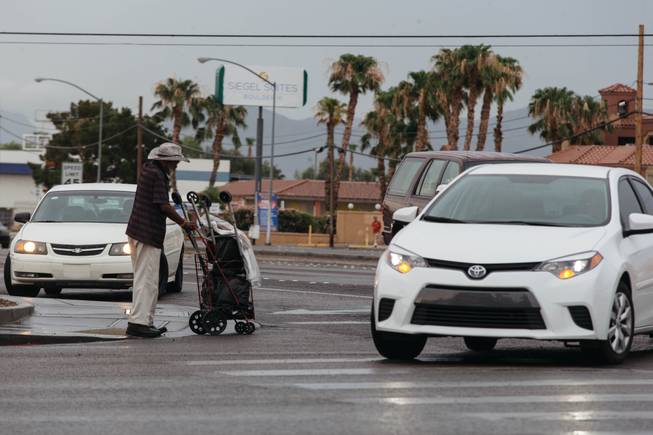
A pedestrian waits to walk through a crosswalk on Boulder Highway as a rainstorm moves across the Las Vegas Valley on Wednesday, July 19, 2017.
Wednesday, Nov. 15, 2017 | 2 a.m.
Related news
This year will likely be the deadliest on record for pedestrians and bicyclists in Southern Nevada.
As of Oct. 30, Clark County saw 59 pedestrian fatalities, up from 41 at the same point last year. Meanwhile, five bicyclists died during that same time period — one more than at the same point last year.
“And that was before (daylight saving time),” said Laura Gryder, the project director of the office of traffic safety grant at UNLV School of Medicine, adding that poor lighting and visibility are often factors in vehicular collisions involving pedestrians and bicyclists. “We will likely see more.”
Fatality data is released at the end of each month by Nevada’s Office of Traffic Safety.
However, Erin Breen, director of UNLV’s Vulnerable Road Users Project, says that by her calculations Clark County this month surpassed its all-time annual high for pedestrian fatalities. By her unofficial count, 63 have died, one more than the all-time high of 62 reached in 1999.
This news comes despite noticeable improvements in bicycle and pedestrian infrastructure throughout the valley, particularly in the cities of Las Vegas and Henderson.
“They have come light years,” says Breen, “and I am not trying to bash anyone, but if we keep our need to allow people to go the speeds they travel, then we will be back here next year.”
Research has shown a direct correlation between vehicle speed and the likelihood of pedestrian survival during a collision. Only 2 percent of people hit by a vehicle traveling 10 to 15 mph and 5 percent of people hit by a vehicle traveling 20 to 25 mph will die as a result. Bump the speed of the vehicle to 30 to 35 mph and the fatality rate for the pedestrian jumps to 45 percent. Once vehicles reach a speed above 40 mph, the risk of fatality for a pedestrian hit is 85 percent.
Breen adds, “You have to address speed or we will keep having his same conversation (about bicycle and pedestrian deaths) over and over again.”
Engineering safety improvements and efforts to educate drivers, bicyclists and pedestrians were at the forefront of discussion during the 2017 Nevada Bicycle and Pedestrian Summit, held Monday and Tuesday at the Suncoast. The summit was hosted by the Southern Nevada Bicycle Coalition, Nevada Department of Transportation and the Regional Transportation Commission of Southern Nevada.
Ideas discussed included partnerships with private car insurance companies to incentivize drivers to take refresher courses on local traffic laws and clarifying vague language regarding when vehicles are allowed to enter crosswalks with pedestrians in them.
“I do continual medical license training every other year,” said August Corrales, the EMS experience coordinator at University Medical Center and avid cyclist. “Do we not need continued education for operating a motor vehicle?”
The Southern Nevada Bicycle Coalition earlier this year launched a campaign titled “More Space! Keep It Safe, Nevada” to promote the state's 3-feet passing law, which requires drivers to provide at least three feet of distance between their vehicles and any bicyclist they are passing. (If a second driving lane is available, drivers must move to the adjacent lane in order to pass a person on a bicycle.)
As part of that campaign, the coalition partnered with local police departments for an enforcement event. Officers passed out 79 citations to drivers during a two-hour ride while people rode on a bicycle; 10 percent of drivers were cited for not following the 3-feet passing law.
A similar enforcement event took place on Oct. 31 at Boulder Highway and Sun Valley — where three people have lost their lives. NDOT recently completed new pedestrian infrastructure at the intersection, including adding rapidly flashing lights to get drivers' attention and a so-called Danish offset that provides walkers with a median refuge between opposing flows of traffic.
“Compliance (with traffic laws) was much better than it had been,” says Breen. “What was startling to me was … that highest speed clocked was 73 miles per hours in a 45. You have to think, how out of touch are we as drivers if, on a small stretch where there are 16 cops with flashing lights, someone is so oblivious to something going on?”
A similar enforcement event is scheduled for Tuesday.
